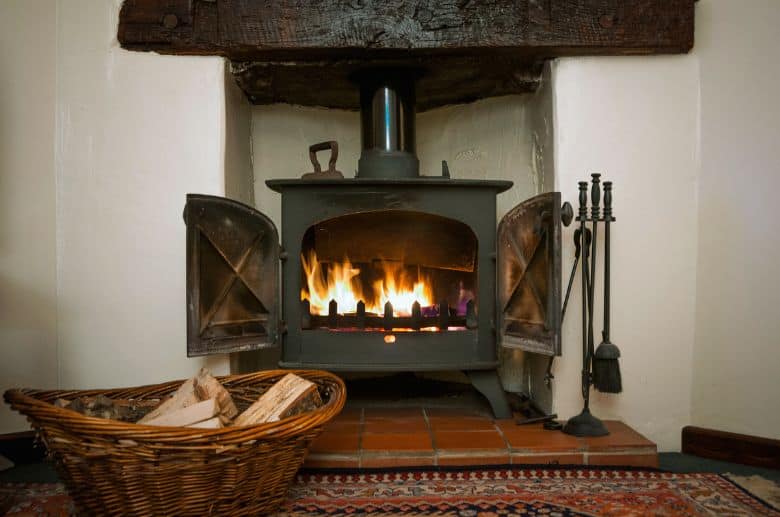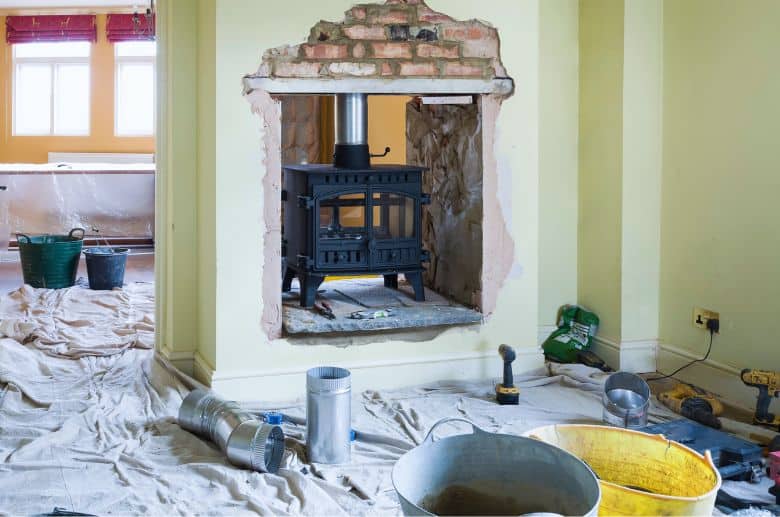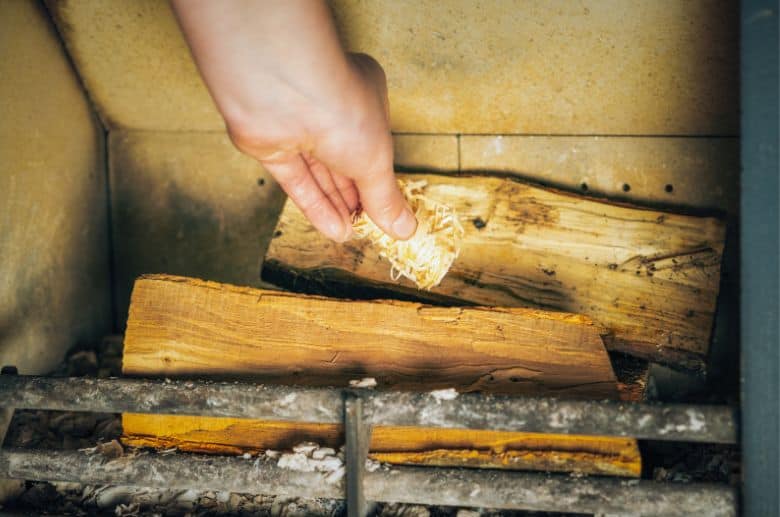Carbon Monoxide (CO) from wood stoves is a deadly gas that is one of the most serious concerns when using a wood stove. It is usually produced when there is a lack of adequate air (oxygen) necessary for proper combustion.
The fact that you can’t see, smell, or taste it makes it even more dangerous. Before you know it, you lose consciousness and, eventually, die. That is why homeowners should be aware of the dangers of CO and preventive measures to avoid it at all costs.
In this article, we will examine the production of carbon monoxide from wood stoves, its effects, and steps you can take to prevent it.
Can You Get Carbon Monoxide Poisoning From a Wood Stove?

You can get Carbon Monoxide (CO) poisoning from a wood stove, but that’s not the only thing that produces Carbon Monoxide. All types of fireplaces also run a danger of CO poisoning.
When comparing wood stove types, it’s essential to consider their efficiency, safety features, and combustion mechanisms to reduce the risk of CO emissions.
Carbon Monoxide is produced anytime improper fuel combustion (coal, natural gas, wood, etc.) occurs. Improper combustion can be due to various reasons, such as inadequate fuel-to-air ratio or improper drafting conditions.
How Does Carbon Monoxide From Wood Stoves Affect You?
To understand how Carbon Monoxide affects your body, it’s important to talk about red blood cells.
Red blood cells contain hemoglobin, a substance that carries oxygen. When you breathe, air reaches your lungs through the windpipe. From here, the oxygen (from the air) attaches to the red blood cells that carry it to all your body’s cells.
Every cell of your body needs oxygen to perform chemical reactions that create energy, which is why oxygen must reach all your body’s cells.
When your wood stove (or other heating equipment) starts releasing Carbon Monoxide (CO), it enters your lungs without you even realizing it. This highlights the importance of comparing stove installations and choosing those that have been tested and proven to emit the least amount of CO.
Since CO has a greater affinity for hemoglobin than oxygen, they attach to the red blood cells.
These CO molecules keep riding the red blood cells and prevent oxygen from being carried. The red blood cells keep circulating throughout the body without oxygen. Since there is no way for oxygen to reach your body’s cells, they stop producing energy and start to die.
That is why Carbon Monoxide poisoning causes cardiovascular complications and brain damage because the cells of these organs start to die. Even small amounts of CO can result in permanent organ damage, especially in older people, children, and people with cardiovascular issues.
——
Do You Need to Hire Chimney & Fireplace Expert?
Get free quotes from qualified experts near you. No commitment required!
——
What are the Symptoms of Carbon Monoxide Poisoning?
Carbon Monoxide (CO) is often called the silent killer because it has no color, smell, or taste and doesn’t even cause any irritation. That is why people are usually unaware of Carbon Monoxide poisoning before it’s too late.
It’s important to know about the various signs and symptoms of CO poisoning. It can help you take preventive measures immediately and keep yourself and your loved ones safe from this dangerous gas.
Common Symptoms of CO poisoning include:
- Nausea
- Headache
- Lethargy
- Shortness of breath
- Dizziness
- Chest pain/tightness
- Loss of muscle control
- Skin redness
The symptoms of CO poisoning and flu are often the same. Moreover, CO poisoning is more common in winter when people frequently use fireplaces. Since flu is also common during this season, people often misinterpret CO poisoning as the flu.
In such cases, most people think it’s best to rest for a while to recover. And that becomes the biggest mistake of their lives. If someone lies down while being exposed to CO, they start to suffocate and quickly lose consciousness. After a while, the vital organs start to fail, eventually leading to the person’s death.
How to Prevent Carbon Monoxide Poisoning When Using Wood-Burning Stoves?
While the dangers of CO poisoning are scary, you don’t need to live in constant fear of Carbon Monoxide off-gassing. Taking a few necessary precautions and being vigilant can prevent your wood stove from leaking Carbon Monoxide.
Proper Installation

Hire a certified professional to install your wood stove. Although No one stops you from installing a wood burning stove by yourself, it is advisable to rely on professionals. Homeowners often fail to follow the manufacturer’s guidelines properly or neglect to implement recommended safety precautions, leading to improper installations and heightened CO leakage risk.
A professional, on the other hand, ensures all state regulations and building codes are met. Moreover, hiring professional help leaves you with the peace of mind that the stove is installed properly, so there’s little chance of a CO leak.
Installing Carbon Monoxide Detectors
Due to their crucial role, most states in the United States mandate the installation of CO detectors in homes and buildings with fossil-fuel-burning appliances.
Here are a few key points to consider when installing CO detectors:
- Purchase CO detectors that meet Underwriters Laboratories (UL) safety standards.
- Install CO detectors on each level of your home, in rooms containing heating appliances, and close to bedrooms.
- Inspect and change the batteries in your CO detectors seasonally.
- Replace CO detectors every 5 years.
Annual Chimney Inspections and Maintenance
NFPA recommends chimney inspection at least once every year. Hire a certified chimney expert to ensure all parts of your fireplace, wood stove, and chimney are in proper working order. If there are malfunctioning or broken parts, the chimney expert will fix them.
You should also ensure regular cleaning and maintenance of your chimney. That’s because soot and creosote can accumulate inside your chimney and cause drafting problems. A chimney clogged with creosote increases the chance of CO leaks as well as chimney fires.
If your wood stove and chimney are well-maintained and annually inspected, the chances of CO leakage and other issues are minimized.
——
Do You Need to Hire Chimney & Fireplace Expert?
Get free quotes from qualified experts near you. No commitment required!
——
Enough Air Supply
Make sure there’s proper ventilation inside the room with the wood-burning stove. An adequate supply of air ensures enough oxygen to ensure the complete combustion of the firewood.
And even if there is a CO leak from your stove, there’s little chance for CO to reach deadly levels in a well-ventilated room.
Wood Stove Damper
When starting your wood-burning stove, ensure the damper is fully open. This will allow maximum airflow, providing enough oxygen for the wood to burn properly. Once the fire is fully ignited, reduce the damper opening to one-fourth. This will allow harmful gasses to exhaust out through the chimney.
Burn Well-Seasoned Firewood

The type of wood you use in your stove affects the combustion.
If you use unseasoned firewood, or improper combustion occurs. Moisture in unseasoned wood makes it harder to burn properly. Improper combustion produces soot, creosote, and Carbon Monoxide.
Well-seasoned firewood contains lower amounts of moisture and burns more efficiently. Since proper combustion occurs, only small quantities of combustion by-products (soot, CO, etc.) are produced.
The Takeaway
Wood-burning stoves that are not regularly cleaned and properly maintained can potentially leak Carbon Monoxide. This can be dangerous as CO is a deadly gas that can cause many ailments, such as cardiovascular complications, brain damage, and even death.
While detecting CO from wood stoves is challenging, signs like window condensation, soot marks around the stove, and poor drafting may indicate a gas leak.
Hiring a professional to install your wood stove is important to avoid CO leaking. You should also install CO detectors on all house floors, ensure proper ventilation, and schedule an annual inspection and regular maintenance for your stove.
FAQs
How do I know if my stove is leaking Carbon Monoxide?
Carbon Monoxide is hard to detect because it’s colorless, odorless, and tasteless. However, there are a few signs of a stove leaking CO that you can look out for:
- Brownish-yellow marks of soot around the stove
- Back-draft from the chimney or the leaking appliance
- Poor draft inside the chimney liner
- Yellow flame instead of blue
- Slow burning of wood
- Weird gas smells coming from the wood stove
- Condensation on the window panes
If you notice any of these signs, call a professional immediately to see if your wood stove is leaking Carbon Monoxide.
Does Carbon Monoxide make you sleepy?
One of the signs of Carbon Monoxide poisoning is lethargy and sleepiness. That’s because when you’re exposed to Carbon Monoxide, it replaces the oxygen molecules in the red blood cells. Since oxygen doesn’t reach different parts of your body, energy is not produced. This causes fatigue, sleepiness, and even death.
How long does it take for Carbon Monoxide to leave your house?
The time needed for Carbon Monoxide can vary depending on whether your house is well-ventilated. Moreover, Carbon Monoxide also escapes through the exhaust pipes. But there is no way to measure CO’s duration to dissipate.
You’ll need to call in a professional to ensure all CO has left your home. S/he will use professional-grade CO detectors to ensure no CO is left in the house.






